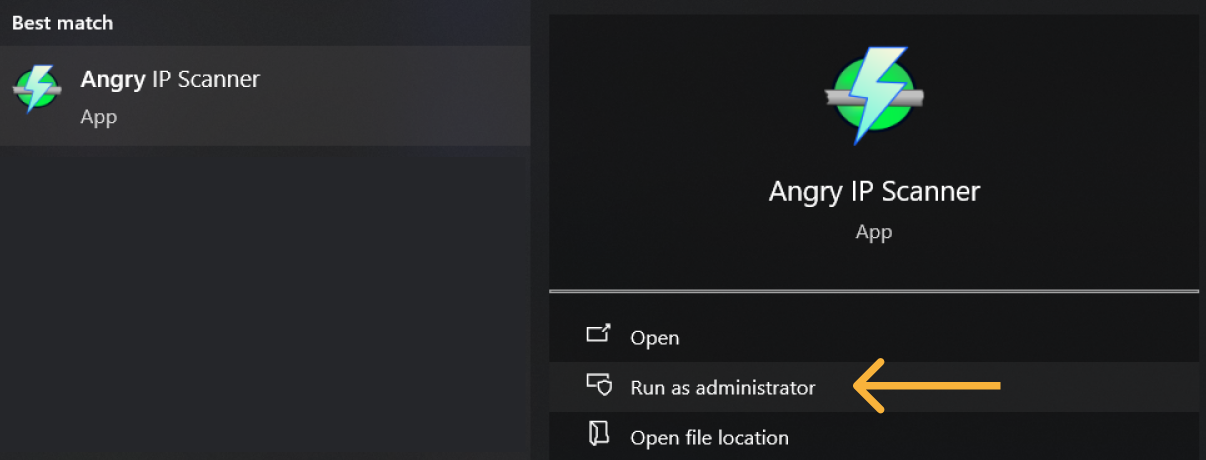IP Address Issues
- I can't find my IP address
- IP doesn't show up on LCD, but can be found using an IP scanner to find the IP
- 2.1 Check the USB cable connecting your printer to your Pi / Hub
- 2.2 Your firmware does not support the
M117gcode command
1. I can't find my IP address
1.1 Try using an ethernet connection instead of WiFi
Ethernet is the most reliable way to connect your Pi / Hub to your network. If you have an ethernet cable, try connecting your Pi / Hub to your router directly. If you can access the dashboard with an ethernet connection, then you know the issue is related to Wifi. We strongly recommend using ethernet if possible.
If you need to use WiFi, then make sure your Pi / Hub is close to your router, and double check your Wifi name and password were entered correctly.
1.2 Scan your network to manually find your IP
Download Angry IP Scanner, run the program as Administrator, and scan your network to find the IP of your Raspberry Pi / Rock64.

IP addresses usually start with 192.168.1.x 10.1.10.x, or 10.0.x.x.

If Angry IP scanner doesn't show anything named rock64 or raspberrypi , then log into your router and you should be able to find the IP address of your Pi / Hub.
Finally, you can try running the command arp -a in the command prompt (Windows) or terminal (Mac/Linux) to find the IP address of your Pi / Hub. It will list out all the devices connected to your network. Check for any devices with a dynamic IP address.
Once you find your IP address, type in https://<YOUR_IP_ADDRESS>:8080 into your browser. For example: https://192.168.1.123:8080. If you see the AutoFarm3D dashboard, then you're good to go!
1.3 Check to see if your Raspberry Pi is underpowered. Ensure your RPi power supply is rated for at least 3 amps
- If you purchased a Print Farm Hub, then you can skip this step.
- You can tell your Pi is underpowered if it continuously cycles through reboot (flickers rapidly for 5-10s, turns off, and repeats the flicker).
- If your power supply cannot supply at least 3 amps, then performance can be unstable. Your Pi may appear to work fine with a 2 amp supply, but under heavy load, it will require more power. Invest in a high-quality 3 amp power supply to avoid future headaches.
1.4 Ensure the RPI is booting properly
You can check the green LED lights on the RPi near the power cable. You will be able to see a red solid light at all times, and a green one that may flicker.
- When SD not read properly, solid green for 15s, blink 4 times, solid green again
- When no SD card/ not pushed in all the way, it will blink green, then solid green
- Good SD card, flickers green rapidly on boot, occasional flicker of green after (no solid green at all)
- If your SD card is corrupt, it will blink green 8 times.
- Solid red + no green at all: Turn off all 3D printers connected to the Pi. Turn off the Pi. Wait 10 seconds. Turn on the Pi. Turn on the 3D printers.
- Tried everything and still not working? Re-image your SD card following the instructions in the Raspberry Pi Setup Guide.
2. IP doesn't show up on LCD, but can be found using an IP scanner to find the IP
2.1 Check the USB cable connecting your printer to your Pi / Hub
- Make sure it is plugged in on the Pi/Hub side, as well as the printer side.
- Make sure it supports data transfer, not just power transfer.
- Make sure the cable isn't broken.
- If in doubt, try a different USB cable.
2.2 Your firmware does not support the M117 gcode command
If you have a Creality 4.x.x board (commonly shipped with Ender 3 V2, and some newer Creality machines) you'll have to update to Jyers firmware which supports M117.
If you have a Prusa Mini, it unfortunately doesn't support M117. There is unofficial firmware that supports M117 (and other nice features) but it requires breaking the appendix, and voiding the warranty of the Prusa Mini's electronics, so do this at your own risk.
3. My IP address shows up as 0.0.0.0 on the printer's LCD
3.1 Your WiFi information is missing or incorrect
-
Double check your SSID (wifi name) and password.
-
For Raspberry Pi, you'll have to re-image your SD card using Raspberry Pi Imager. In the 'advanced settings' make sure the SSID (WiFi name) and password is correct.
-
For Print Farm Hub, double check the wifi.txt file. Make sure there are no spaces after the colon or at the end of your SSID/password.
Example wifi.txt:
Put your wifi information below, it is case sensitive. Type it directly after the colon:like this.
network-name:ExampleNetworkName password:ExamplePassword
4. The IP address shows up as 127.0.0.x
You may have set a static IP for your RPi or Print Farm Hub, but something else is connected to that IP address.
- Use an IP scanner, such as, Angry IP Scanner or log in to your router to check if something else is taking that IP address.
- If so, set a different static IP for your Pi / Hub.